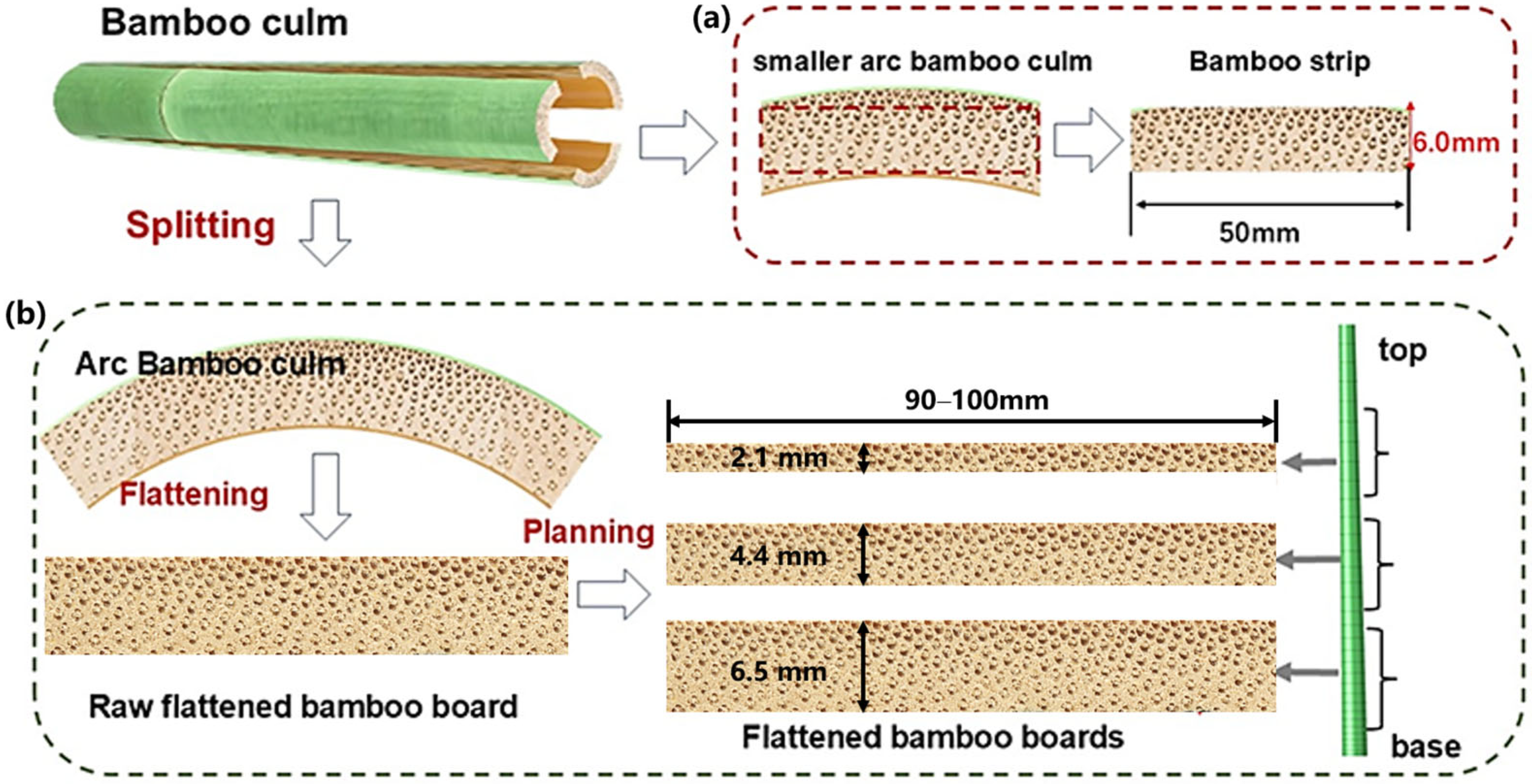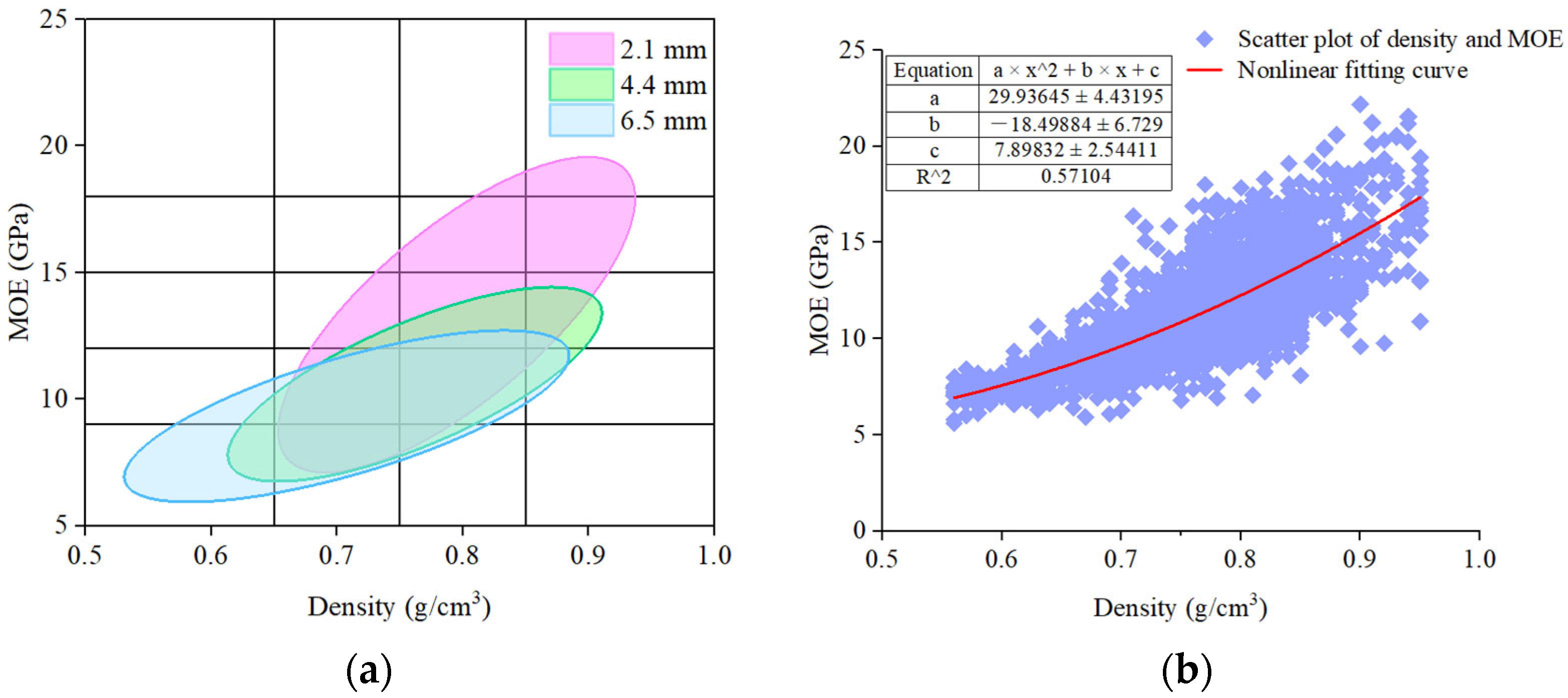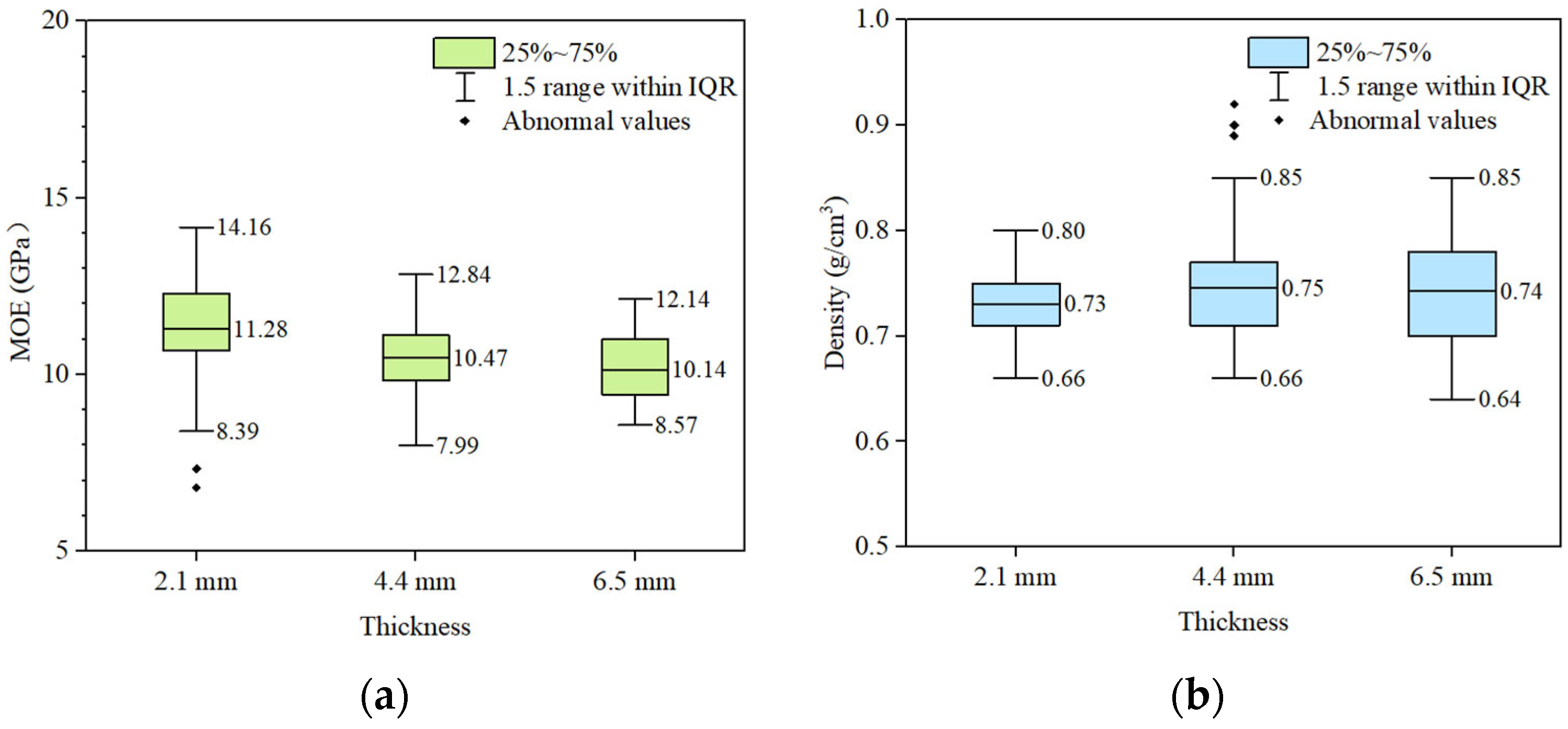Density and Modulus of Elasticity (MOE) Distribution and Grading of Flattened Bamboo Boards
Abstract
1. Introduction
2. Materials and Methods
2.1. Materials
2.2. Methods
2.3. Statistical Analyses
3. Results
3.1. Variability and Distribution of Density and MOE in Flattened Bamboo Boards
| Units | Thicknesses (mm) | Density | MOE | |||||||
|---|---|---|---|---|---|---|---|---|---|---|
| Density Range (g/cm3) | Average (g/cm3) | SD (g/cm3) | CV (%) | MOE Range (GPa) | Average (GPa) | SD (GPa) | CV (%) | |||
| Flattened bamboo boards | 2.1 | 0.55–1.12 | 0.80 | 0.07 | 8.66 | 5.94–22.18 | 13.35 | 2.54 | 19.07 | |
| 4.4 | 0.61–1.10 | 0.76 | 0.07 | 9.71 | 7.09–20.47 | 10.59 | 1.56 | 14.76 | ||
| 6.5 | 0.46–0.94 | 0.70 | 0.08 | 11.78 | 5.60–13.28 | 9.32 | 1.39 | 14.91 | ||
| Total | 0.46–1.12 | 0.76 | 0.08 | 10.97 | 5.60–22.18 | 11.28 | 2.56 | 22.74 | ||
| Dimension bamboo strips [29] | 6.0 | 0.51–0.81 | 0.71 | 0.08 | 10.04 | 4.86–15.06 | 10.81 | 1.74 | 16.08 | |
| Bamboo properties at different heights [30] | 1–3 m | 9.7 | 0.71 | - | - | - | 6.52 | - | - | - |
| 3–5 m | 8.4 | 0.76 | - | - | - | 7.67 | - | - | - | |
| 5–7 m | 7.1 | 0.77 | - | - | - | 9.86 | - | - | - | |
3.2. Grading on Density and Modulus of Elasticity of Flattened Bamboo Boards
3.3. Correlation Between Density and MOE in Flattened Bamboo Boards
4. Conclusions
Author Contributions
Funding
Data Availability Statement
Acknowledgments
Conflicts of Interest
References
- Liu, K.W.; Xu, Q.F.; Wang, G.; Chen, F.M.; Leng, Y.B.; Yang, J.; Harries, K.A. Contemporary Bamboo Architecture in China; Springer Nature: Dordrecht, The Netherlands, 2022. [Google Scholar]
- Jing, G.; Zhang, R.; Ngamkhanong, C.; Tavakol, M. Mechanical performance and dynamic characteristics of a novel bamboo-plywood composite railway sleeper. Constr. Build. Mater. 2025, 476, 141264. [Google Scholar] [CrossRef]
- Sharma, B.; Gatoo, A.; Bock, M.; Mulligan, H.; Ramage, M. Engineered bamboo: State of the art. Proc. Inst. Civ. Eng. Constr. Mater. 2015, 168, 57–67. [Google Scholar] [CrossRef]
- Ma, Y.; Luan, Y.; Chen, L.; Huang, B.; Luo, X.; Miao, H.; Fang, C. A Novel Bamboo–Wood Composite Utilizing High-Utilization, Easy-to-Manufacture Bamboo Units: Optimization of Mechanical Properties and Bonding Performance. Forests 2024, 15, 716. [Google Scholar] [CrossRef]
- Li, P.; Ji, S.; Mou, Q.; Zheng, X.; Li, X.; Li, X. Variations of the fundamental chemical components in Moso bamboo (Phyllostachys pubescens). Wood Mater. Sci. Eng. 2024, 2, 248–256. [Google Scholar] [CrossRef]
- Li, Z.-Z.; Luan, Y.; Hu, J.-B.; Fang, C.-H.; Liu, L.-T.; Ma, Y.-F.; Liu, Y.; Fei, B.-H. Bamboo heat treatments and their effects on bamboo properties. Constr. Build. Mater. 2022, 331, 127320. [Google Scholar] [CrossRef]
- Zhang, K.; Yu, L.; Dai, F.; Chen, Y.; Wang, Y.; Jiang, Z.; Tian, G. Predicting the compression properties of Phyllostachys edulis based on the volume of its fiber sheaths. Ind. Crop. Prod. 2024, 222, 119586. [Google Scholar] [CrossRef]
- Ojo, O.O.; Olaleke, M.O.; Alaneme, K.K.; Dahunsi, A.O. Ballistic and impact resistance performance of natural fiber-reinforced composites from biomass resources. Next Mater. 2025, 8, 100565. [Google Scholar] [CrossRef]
- Chen, X.; Wang, X.; Shang, L.; Ma, X.; Fang, C.; Fei, B.; Liu, H.; Zhang, S. Three-dimensional structural characterization and mechanical properties of bamboo parenchyma tissue. Ind. Crop. Prod. 2024, 208, 117833. [Google Scholar] [CrossRef]
- Gao, X.; Zhu, D.; Fan, S.; Rahman, Z.; Guo, S.; Chen, F. Structural and mechanical properties of bamboo fiber bundle and fiber/bundle reinforced composites: A review. J. Mater. Res. Technol. 2022, 19, 1162–1190. [Google Scholar] [CrossRef]
- Wang, F.; Shao, Z. Study on the variation law of bamboo fibers’ tensile properties and the organization structure on the radial direction of bamboo stem. Ind. Crop. Prod. 2020, 152, 112521. [Google Scholar] [CrossRef]
- Guan, S.; Zhao, J.; Li, P.; Tian, L.; Zhang, S.; Zhao, H. Precise control of mechanical performance of natural bamboo by the gradient distribution of fibers and the underlying mechanisms. Compos. Part B Eng. 2025, 294, 112172. [Google Scholar] [CrossRef]
- Kampragkou, P.; Dabekaussen, M.; Kamperidou, V.; Stefanidou, M. Bio-additives in lime-based mortars: An investigation of the morphology performance. Constr. Build. Mater. 2025, 474, 141177. [Google Scholar] [CrossRef]
- McGavin, R.L.; Bailleres, H.; Lane, F.; Fehrmann, J.; Ozarska, B. Veneer Grade Analysis of Early to Mid-rotation Plantation Eucalyptus Species in Australia. BioResources 2014, 9, 6562–6581. [Google Scholar] [CrossRef]
- Breinig, L.; Leonhart, R.; Broman, O.; Manuel, A.; Brüchert, F.; Becker, G. Classification of wood surfaces according to visual appearance by multivariate analysis of wood feature data. J. Wood Sci. 2015, 61, 89–112. [Google Scholar] [CrossRef]
- Ridley-Ellis, D.; Stapel, P.; Baño, V. Strength grading of sawn timber in Europe: An explanation for engineers and researchers. Eur. J. Wood Wood Prod. 2016, 74, 291–306. [Google Scholar] [CrossRef]
- ISO 19624; Bamboo Structures—Grading of Bamboo Culms—Basic Principles and Procedures. International Organization for Standardization: Geneva, Switzerland, 2018.
- Bahtiar, E.T.; Imanullah, A.P.; Hermawan, D.; Nugroho, N. Abdurachman Structural grading of three sympodial bamboo culms (Hitam, Andong, and Tali) subjected to axial compressive load. Eng. Struct. 2019, 181, 233–245. [Google Scholar] [CrossRef]
- Yang, X. Study on Bamboo Grading, Flattening and Preparation and Performance of Dimension Bamboo. Ph.D. Thesis, Chinese Academy of Forestry, Beijing, China, June 2019. [Google Scholar]
- Zong, Y.; Chen, X.; Luo, X.; Su, Q.; Zhang, X.; Yan, Y.; Liu, H. Effect of Bamboo Culm Grading on the Properties of Flattened Bamboo Boards. Forests 2023, 14, 1120. [Google Scholar] [CrossRef]
- Youssefian, S.; Rahbar, N. Molecular Origin of Strength and Stiffness in Bamboo Fibrils. Sci. Rep. 2015, 5, 11116. [Google Scholar] [CrossRef]
- Song, G. Design, Manufacture and Evaluation of Graded Glued Bamboo Lamination for Marine Use. Master’s Thesis, Chinese Academy of Forestry, Beijing, China, June 2016. [Google Scholar]
- Lisheng, X.; Jun, T.; Binbin, L.; Jiacheng, L.; Fangyu, Z. Research on classification of bamboo strips for laminated bamboo produced by lateral pressuring. J. For. Eng. 2023, 8, 43–49. [Google Scholar] [CrossRef]
- Li, Y.; Semple, K.; Huang, J.; Zhang, W.; Dai, C. Acoustic wave method for non-destructive evaluation of flattened bamboo veneers. Constr. Build. Mater. 2024, 428, 136317. [Google Scholar] [CrossRef]
- Yuan, T.; Xiao, X.; Zhang, T.; Yuan, Z.; Wang, X.; Li, Y. Preparation of crack-free, non-notched, flattened bamboo board and its physical and mechanical properties. Ind. Crop. Prod. 2021, 174, 114218. [Google Scholar] [CrossRef]
- GB/T 19367-2022; Determination of Dimensions of Wood-Based Panels. Standardization Administration of the People’s Republic of China: Beijing, China, 2022.
- AITC T116; Modulus of Elasticity for E-Rated Lumber by Static Loading. American Institute of Timber Construction: Englewood, CO, USA, 2007.
- Chen, K.; Long, L.C. Analysis of the Effects of Fiber Gradient Distribution on the Mechanical Properties of Moso Bamboo. Appl. Mech. Mater. 2014, 590, 13–18. [Google Scholar]
- Diao, Q. Specific Modulus Grade of Dimension Bamboo Strips and Manufacture and Evaluation of Bamboo Lamination. Master’s Thesis, Chinese Academy of Forestry, Beijing, China, June 2018. [Google Scholar]
- Yan, Y.; Liu, H.; Zhang, X.; Chen, G.; Wu, H. The effect of Phyllostachys pubescens flutea Wen property on the E-Rated classification of laminated bamboo board. J. Anhui Agric. Univ. 2017, 44, 260–264. [Google Scholar] [CrossRef]
- Wang, X.; Cheng, D.; Huang, X.; Song, L.; Gu, W.; Liang, X.; Li, Y.; Xu, B. Effect of high-temperature saturated steam treatment on the physical, chemical, and mechanical properties of moso bamboo. J. Wood Sci. 2020, 66, 52. [Google Scholar] [CrossRef]
- Grosser, D.; Liese, W. On the anatomy of Asian bamboos, with special reference to their vascular bundles. Wood Sci. Technol. 1971, 5, 290–312. [Google Scholar] [CrossRef]
- Wang, X.; Chen, X.; Li, Y.; Liu, H.; Huang, B.; Fang, C. Thermo-hygro mechanical flattening of bamboo with intact wall structure: Synergistic enhancement of mechanical properties and dimensional stability. Compos. Part B Eng. 2025, 303, 112582. [Google Scholar] [CrossRef]
- Yuan, T.; Wang, X.; Liu, X.; Li, Y. Dynamic response of arc-shaped bamboo sheets during flattening process. Ind. Crop. Prod. 2023, 192, 116073. [Google Scholar] [CrossRef]
- Wang, B.J.; Dai, C. Development of structural laminated veneer lumber from stress graded short-rotation hem-fir veneer. Constr. Build. Mater. 2013, 47, 902–909. [Google Scholar] [CrossRef]
- Wang, B.J.; Dai, C. Hot-pressing stress graded aspen veneer for laminated veneer lumber (LVL). Holzforschung 2005, 59, 10–17. [Google Scholar] [CrossRef]
- Zhou, F.; Wang, X.; Wang, Y.; Li, G.; Dong, C. Study on the Mechanical Properties and Basic Elastic Constants of Yunnan. Dendrocalamus sinicus Chia et J. L. Sun. Forests 2024, 15, 2017. [Google Scholar] [CrossRef]
- Fu, Z.; Lu, Y.; Wu, G.; Bai, L.; Barker-Rothschild, D.; Lyu, J.; Liu, S.; Rojas, O.J. Wood elasticity and compressible wood-based materials: Functional design and applications. Prog. Mater. Sci. 2024, 147, 1013514. [Google Scholar] [CrossRef]
- Luan, Y.; Ma, Y.-F.; Liu, L.-T.; Fei, B.-H.; Fang, C.-H. A novel bamboo engineering material with uniform density, high strength, and high utilization rate. Ind. Crop. Prod. 2022, 184, 115045. [Google Scholar] [CrossRef]





| Grades | Range (g/cm3 or GPa) | Proportion (%) | Proportion of Different Thickness (%) | Hem-Fir Veneer [35] | Populus Tremuloides Veneer [36] | ||
|---|---|---|---|---|---|---|---|
| 2.1 mm | 4.4 mm | 6.5 mm | |||||
| D1 | >0.85 | 10.9 | 16.7 | 11.2 | 2.6 | - | - |
| D2 | (0.75, 0.85] | 41.9 | 58 | 36.4 | 27.3 | - | - |
| D3 | (0.65, 0.75] | 38.2 | 24.2 | 49.3 | 42.2 | - | - |
| D4 | ≤0.65 | 9.0 | 1.1 | 3.1 | 27.9 | - | - |
| E1 | >18 | 1.8 | 4.5 | 0.3 | 0 | 15.17 (1.57 1) | 13.24 (1.03 1) |
| E2 | (15, 18] | 8.1 | 20.7 | 1.2 | 0 | 11.86 (0.76 1) | 12.14 (0.90 1) |
| E3 | (12, 15] | 22.4 | 43.4 | 15.4 | 2.4 | 9.17 (0.97 1) | 10.35 (1.10 1) |
| E4 | (9, 12] | 51.4 | 28.2 | 70.4 | 58.0 | - | - |
| E5 | ≤9 | 16.3 | 3.2 | 12.7 | 39.6 | - | - |
| MOE variance analysis of flattened bamboo boards | |||||||
| Source of variation | SS | df | MS | F | p-value | F crit | Significance |
| Intergroup | 8562.74 | 3 | 2854.25 | 871.85 | 0 | 3.79 | *** 2 |
| Within group | 8456.20 | 2583 | 3.27 | ||||
| Total | 17,018.94 | 2586 | |||||
| Density variance analysis of flattened bamboo boards | |||||||
| Source of variation | SS | Df | MS | F | p-value | F crit | Significance |
| Intergroup | 7.13 | 4 | 1.78 | 746.74 | 0 | 3.33 | *** 2 |
| Within group | 6.17 | 2582 | 0.0024 | ||||
| Total | 13.30 | 2586 | |||||
Disclaimer/Publisher’s Note: The statements, opinions and data contained in all publications are solely those of the individual author(s) and contributor(s) and not of MDPI and/or the editor(s). MDPI and/or the editor(s) disclaim responsibility for any injury to people or property resulting from any ideas, methods, instructions or products referred to in the content. |
© 2025 by the authors. Licensee MDPI, Basel, Switzerland. This article is an open access article distributed under the terms and conditions of the Creative Commons Attribution (CC BY) license (https://creativecommons.org/licenses/by/4.0/).
Share and Cite
Luo, X.; Xu, J.; Li, Y.; Song, Z.; Jiang, Z.; Zhang, X.; Dai, C.; Miao, H.; Liu, H. Density and Modulus of Elasticity (MOE) Distribution and Grading of Flattened Bamboo Boards. Forests 2025, 16, 1163. https://doi.org/10.3390/f16071163
Luo X, Xu J, Li Y, Song Z, Jiang Z, Zhang X, Dai C, Miao H, Liu H. Density and Modulus of Elasticity (MOE) Distribution and Grading of Flattened Bamboo Boards. Forests. 2025; 16(7):1163. https://doi.org/10.3390/f16071163
Chicago/Turabian StyleLuo, Xun, Jiarui Xu, Yuquan Li, Zhiru Song, Zhen Jiang, Xiubiao Zhang, Chunping Dai, Hu Miao, and Huanrong Liu. 2025. "Density and Modulus of Elasticity (MOE) Distribution and Grading of Flattened Bamboo Boards" Forests 16, no. 7: 1163. https://doi.org/10.3390/f16071163
APA StyleLuo, X., Xu, J., Li, Y., Song, Z., Jiang, Z., Zhang, X., Dai, C., Miao, H., & Liu, H. (2025). Density and Modulus of Elasticity (MOE) Distribution and Grading of Flattened Bamboo Boards. Forests, 16(7), 1163. https://doi.org/10.3390/f16071163







